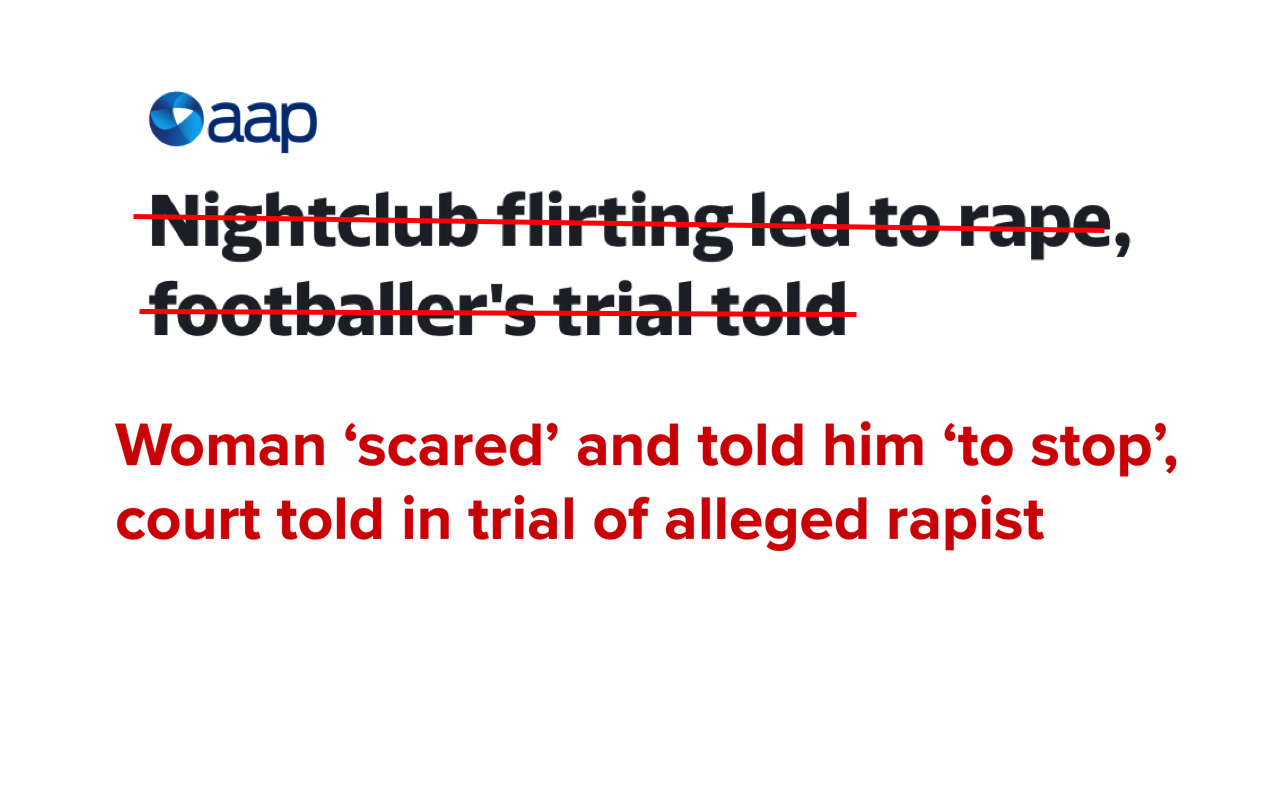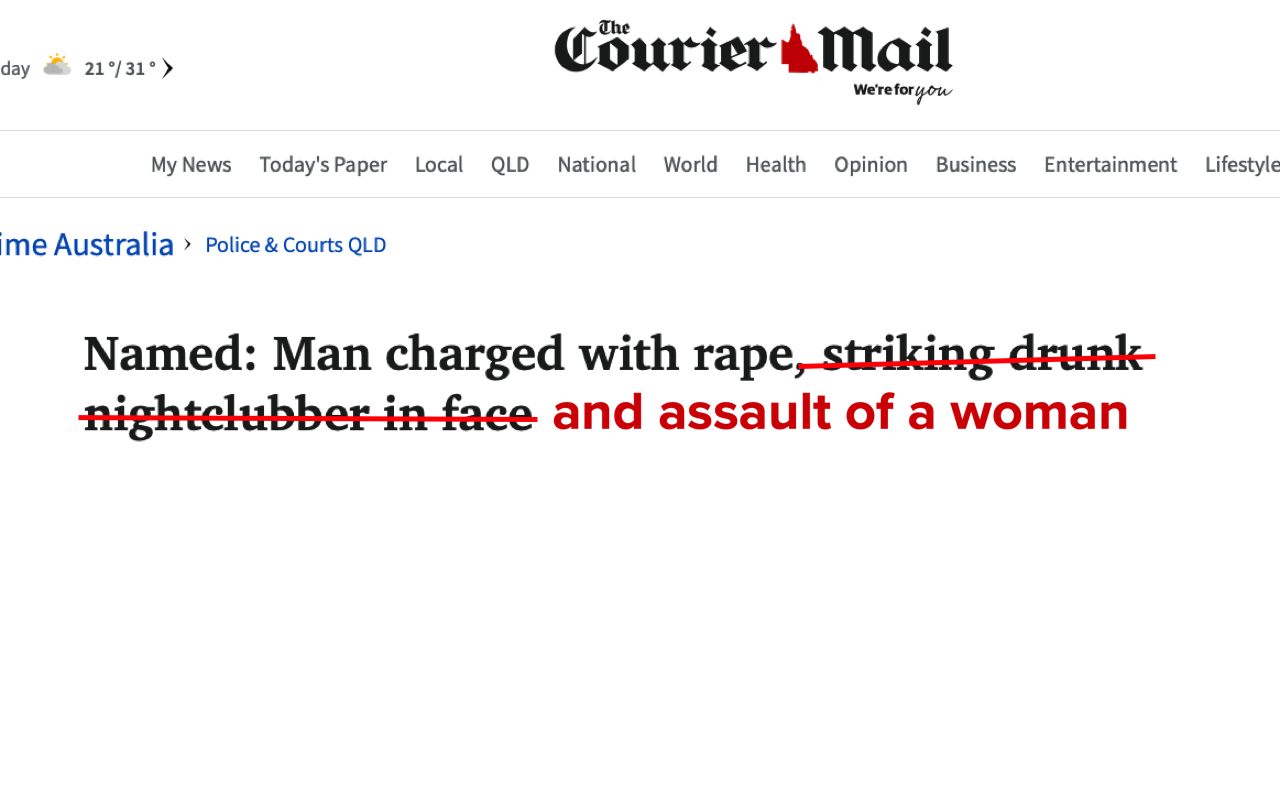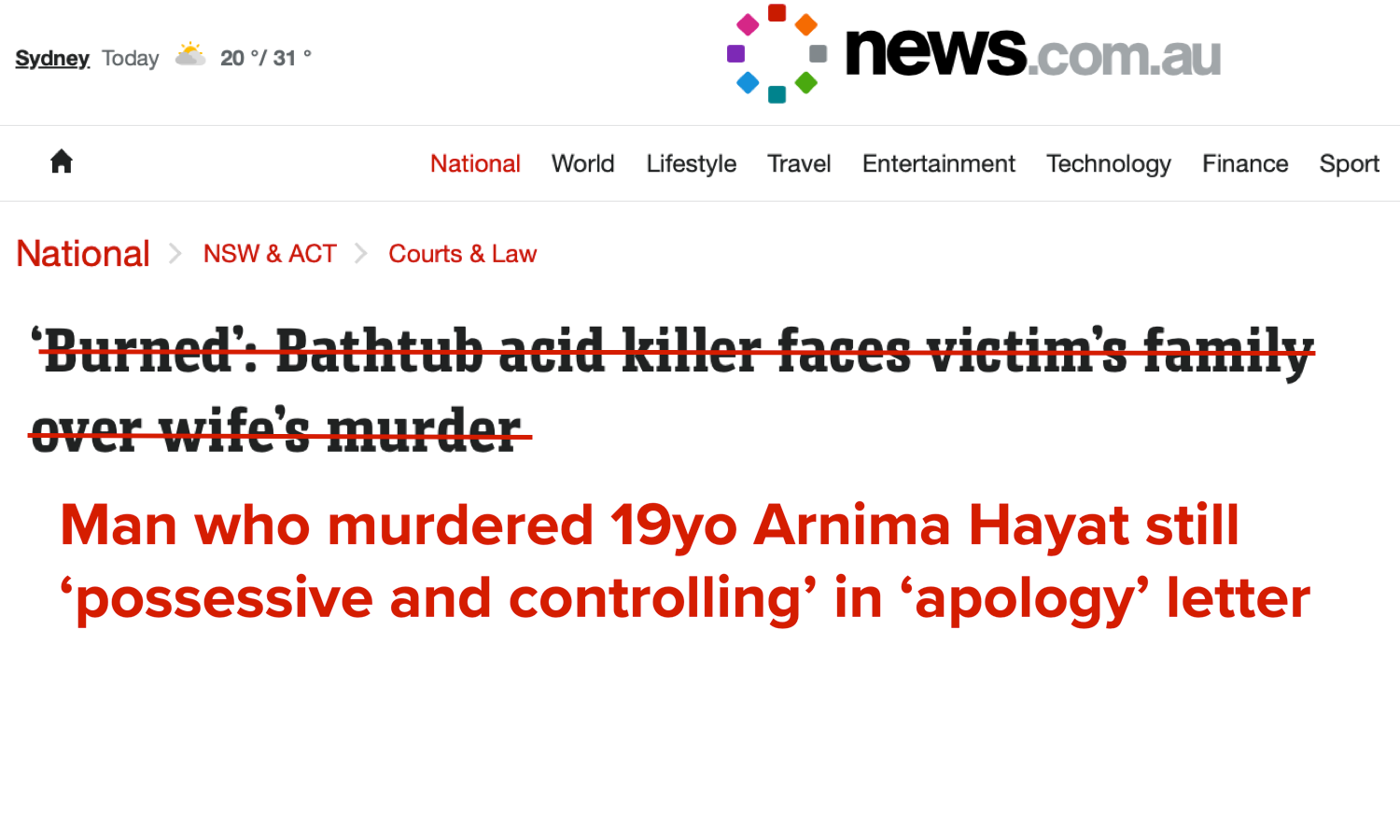Extract from my book, FixedIt: Violence and the representation of women in the media, published by Penguin Random House:
The Good Bloke, the Great Guy, the Loving Father, the Amazing Hubby, the Pillar of Society. Also known as: the man who killed his partner and/or children. The Good Guy trope is so ubiquitous in news reports about men who committed suicide after murdering their partners and children that it was almost impossible to find a media report on this crime that didn’t include a Good Guy reference.
In Wangaratta during April 2017, Ora Holt and her children were chased from their home at gunpoint by Greg Floyd, her husband and the father of the children. Ora fled to a neighbour’s house and put herself between her armed husband and their children. He shot her, then himself.
The ABC quoted a Wangaratta local as saying, ‘He seemed to me to be a decent young fellow, who worked hard in order to protect and feed his family.’
The Herald Sun quoted Floyd’s sister: ‘Everyone will tell you he was an excellent person, there wasn’t a bad bone in his body.’
News.com.au reported a former neighbour saying there had never been signs of trouble at the property. ‘“They’re pretty good people,” he said.’
Kidspot wrote, ‘The family have been described as loving and normal. Neighbours say they had never even heard Floyd yell at his kids.’
The Age quoted a local resident as saying, ‘They were very nice people.’
In other words, every major news outlet in the state included some form of Good Guy quote in an article about a man who chased his wife and children out of their home with a gun before killing his wife in front of their children. The only reason Floyd got the Good Guy treatment was because he was her husband. If he had been a stranger, or worse, a Muslim stranger, he’d have been demonised in the press as a monster and a terrorist. The fact that some of his neighbours liked him is not relevant to the crime he committed, and yet it was reported in almost every single article about the murder he committed.
In October 2016, Fernando Manrique planned an elaborate construction of pipes to deliver poisonous gas into the home where his wife, Maria, and their children, Martin and Elisa, were sleeping. The murders occurred not long after Maria had told him she wanted a divorce. The headline of the report in a leading newspaper was: ‘“A horrific thing”: the death of the Manrique-Lutz family’. It truly was a horrific thing, but it was not a simple ‘death’ of the family. It was not a tragic accident or unforeseeable disaster, but a meticulously planned murder. Again, if it had been committed by anyone but the husband and father, it would have been called a massacre, not a death, and the murderer would have been vilified in a series of outraged articles about the vicious and unforgivable murder of innocent women and children.
Also included in the article was an interview with a friend of Manrique who ‘remembers Manrique as a private but warm man who cared deeply for his children’. This ‘warm man’ spent weeks planning their murder. It should go without saying that this is not how men who care for their children behave.
Kidspot, under the headline ‘Davidson Family Tragedy: Was Mum struggling to cope?’ (Davidson is the location of the murder, not the name of the murdered family), quoted neighbours saying, ‘Maria had been feeling the burden of raising two children with autism.’ While it’s certainly true that services for autistic children could be improved, describing murdered autistic children as a ‘burden’ rather than assuming they were, as was the case with these children, beloved sons and daughters, is particularly abhorrent. As evidence gathered over time proved, Maria was in fact a devoted mother, entirely prepared to care for her two children by herself.
In March 2016, Arona Peniamina stabbed his wife, Sandra Peniamina, to death in front of their ten-year-old son. They also had another three younger children. Paramedics who attended described the attack as one of the worst they had ever seen. SBS reported that his aunt described Peniamina as ‘a really good man’. The Brisbane Times repeated the quote and added that he ‘just wanted to work hard for his family’.
In September 2014, grain farmer Geoff Hunt killed his wife, Kim, and their three children at their home in Lockhart, in the New South Wales Riverina region, before shooting himself.
Under the headline ‘Strains that grew inside Geoff Hunt ended in five deaths on a farm’ and a picture of a happy-looking couple, the Sydney Morning Heraldreported that one of his friends said, ‘You couldn’t get a better bloke. The most gentle, considerate bloke … a pillar of society.’
The Weekend Australian reported, ‘He has done a horrific thing, yet Lockhart remembers Geoff Hunt as a good man,’ followed by a quote from one of Hunt’s friends saying, ‘Geoff is one of the kindest, most caring fathers you would ever find.’
Damien Little, who shot his two sons then drove off a wharf with their bodies in his car, was described by Australia’s national broadcaster as ‘respected and well liked’; coverage quoted a friend as saying, ‘You couldn’t have asked for a better bloke.’
The arrest of Chris Watts in Colorado, United States, who confessed to killing his pregnant wife, Shanann, and two small daughters, was reported by the BBC under the headline: ‘“Amazing hubby” held after missing family “found dead in fuel tanks”’. The article included copies of several social media posts by Shanann praising Watts as a loving husband and father. At the time, Watts had been arrested but had not yet confessed to the murders. In sharing these posts by a murdered woman, the BBC showed a staggering level of ignorance. Do they think women in violent relationships commonly post pictures of their bruises and details of the abuse they suffer?
In Ireland in early 2016, Alan Hawe stabbed his wife, Clodagh, to death. Then he walked upstairs with a knife and a hatchet and murdered their three sons. The youngest, Ryan, was six years old and he had defensive wounds, indicating he was probably awake and trying to defend himself when his father killed him. Hawe then wrote a note saying he’d killed his family because he didn’t think they could live without him, and hanged himself.
News reports across Ireland lauded him as ‘a brilliant dad’, ‘a valuable member of the community’, ‘the most normal person you could meet’, ‘quiet and a real gentleman’ and ran photos of Hawe and his sons, but none of Clodagh. Journalists ascribed the murders to mental illness and, had it not been for an impassioned blog by Irish feminist Linnea Dunne, the story might have ended there. Dunne’s post, called ‘Rest In Peace, Invisible Woman’, eviscerated the media reporting of Hawe’s crimes. She pointed out how often the mentally ill are targets of abuse but rarely the perpetrators of it, and that the idea a family had no right to live if their father chose to die was patriarchal bullshit, not mental illness. The post went viral and the hashtag #HerNameIsClodagh began trending on Twitter as women in Ireland, followed by women all over the world, protested Clodagh’s erasure from the reports on her murder while the man who killed her was given empathy and excuses.
“A man murders four people in Cavan, and we are fed questions and statements of disbelief alongside praise of the murderer as a community man. On the front pages, we see the man and the three children he murdered. Two days in, Clodagh has all but become invisible. And you ask why feminists are so loud and angry?” – Linnea Dunne
These are just some of the countless examples of the Good Guy narrative in reports of murder–suicides. They occur across all spectrums of media around the world and listing all of them would fill this entire book plus a sequel.
Until recently, this was the standard template for reporting on men who commit murder–suicides. It rarely, however, applied to the few women who did it. Some of the impetus for the Good Guy story comes from the issue discussed earlier – reporting each killing as a separate incident rather than part of a recurring pattern of male violence – but there are other factors at play. Murder–suicides, particularly when they involve children, make for emotive news. They are one of the very few instances where men’s violence against women will make the front page. Journalists operate on tight deadlines and usually with little information. Police are understandably reluctant to release details in the first few days after a multiple murder, when they have not had time to process evidence, interview witnesses or confirm theories. Neighbours and friends are often gathering on the street in shock, trying to make sense of what happened. They make easy targets for journalists looking for quotes. And unless the journalists have had training or experience in dealing with family violence, it probably doesn’t occur to them that men who are violent with their partners and children rarely display such behaviour in public. In fact, such men often go out of their way to portray themselves as loving fathers and husbands, because it makes it that much more difficult for their partners to ask for help and less likely they will be believed if they do. It’s also possible these men also do possess some good qualities, which are discernible and evident to the people around them. The idea that violence against women is only committed by obviously evil men is one of the reasons women find it so difficult to report family violence and find people to believe them when they do.
Journalists reporting these stories search for quotes to explain why this particular murder happened, what went wrong for this particular man and what this particular woman did to provoke him. They might find quotes to suggest mental illness or depression but almost never ask why, if that were the cause (which is isn’t, people with mental illness are far more likely to be victims than perpetrators of violence), the man in question chose to kill his family. Why wasn’t he attacking people on the street or in his workplace or at his church or sports club? The reason is that he didn’t ‘snap’. He made a choice.
Including descriptions of a perpetrator’s good qualities is not sound journalistic practice, according to the University of Melbourne’s Dr Denis Muller.
“The ethical duty of a journalist is to consider the impact of what they write on all parties. To allow a perpetrator of a crime like this to be portrayed as someone who had good qualities is getting into the territory of irresponsibility. They may have had good qualities – most people do. But the context is of a gross crime. And so it doesn’t seem to me to be the responsible thing to do, to in some way build up the perpetrator in a positive light.”
Rather than reaching for the easy Good Guy quote from distressed but ill-informed friends and neighbours, some responsible journalists have recently started including more information on the context of murder–suicides in family violence by linking them to previous cases and evidence-based data on the typical history of family violence in such crimes. They’ve also started including quotes from family violence experts who can put the crime into perspective by explaining the gendered history and that while men killing their partners and children is tragically common (around twenty per year in Australia), it is almost unheard of for women. It is true that women sometimes kill themselves and their children, but the circumstances are usually different and they almost never kill their partners as well; this is a uniquely male crime. Adding this kind of commentary to reports of murder-suicides avoids the event-based reporting that focuses solely on the individuals, while also helping both public and friends and family understand these crimes as expressions of violent power and control underpinned by misogyny.
Monash University researcher Gary Dickson’s study of the news media’s reporting on ‘one punch’ hits found that over the summer of 2013–14 the Sydney Morning Herald and the Daily Telegraph published fifty-four articles between them about the killing of Thomas Kelly in 2012 and Daniel Christie in 2013. Both publications called for drastic reform in how the justice system dealt with one punch hits fuelled by drugs and alcohol. Within weeks of this barrage, then Premier Barry O’Farrell announced new laws would be introduced to combat alcohol-fuelled violence. When Dickson compared the reporting of one-punch hits and men’s violence against women, he found ‘that in cases of men’s violence against women, the men are given a greater opportunity to speak for and represent themselves than in cases of violence against other men’, the implication being that when men are violent to women there is a reasonable excuse that does not exist when they are violent to other men. He also showed that men’s violence against women is more likely to be sensationalised than men’s violence against other men.
To read more from the book FixedIt: Violence and the representation of women in the media, you can borrow it from your local library, or order through Booktopia, Audible or your favourite bookstore.
—
FixedIt is an ongoing project to push back against the media’s constant erasure of violent men and blaming of innocent victims. If you would like to help fund it – even $5 a month makes a big difference – please consider becoming a Patron
1800 RESPECT
Sexual assault, domestic and family violence counselling and support.24 hours a day, 7 days a week.
Ph: 1800 737 732
www.1800respect.org.au
Djirra – Aboriginal Family Violence Response & Support Service
9am – 9pm, Monday to Friday
Ph: 1800 105 303
djirra.org.au
Suicide Call Back Service
24 hours a day, 7 days a week.
Ph: 1300 659 467
www.suicidecallbackservice.org.au
Kids Helpline
24 hours a day, 7 days a week.
Phone: 1800 55 1800
www.kidshelp.com.au
MensLine Australia
24 hours a day, 7 days a week.
Phone: 1300 78 99 78
www.mensline.org.au



